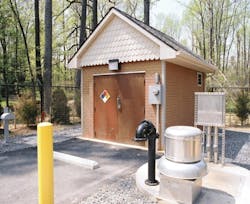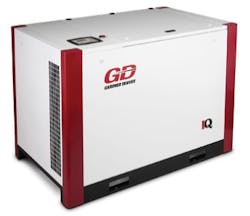Fairfax County's wastewater system serves an area covering more than 230 square miles and can collect and clean more than 160 million gallons of wastewater per day from about 340,000 homes and businesses. The wastewater management system consists of approximately 3,200 miles of pipe, dozens of pumping stations and several treatment facilities.
When the 30-year-old emergency standby generators at three wastewater pump stations required upgrading, project officials determined it was more cost-efficient to completely replace the units with standby power systems from MTU Onsite Energy than to make the needed upgrades to the existing generators. The new units bring backup power online much faster, and they are more compact, easier to maintain and easier on the environment than their predecessors.
The Wastewater Collection Division's Pumping Stations Branch operates and maintains the wastewater pump stations, flow meters, a pressure sewer system and several facilities that add chemicals to control odor and corrosion. Unmanned and completely automated, each of the Fairfax County pump stations requires a standby power source that automatically comes online to keep the pumps running and wastewater flowing through the collection system when utility power is lost.
Recently, Cynergy Electric Company, an electrical contractor in Crofton, MD, completed a yearlong project for Alpha Construction Co., Upper Marlboro, MD, to replace old backup power systems at three of the pumping stations. The original contract called only for upgrades and repairs of the existing standby generators at the three pumping stations. But after completing a cost-benefit analysis, officials at Alpha recommended replacing the existing generators instead of upgrading the old ones. The benefits of improved response time, reliability and reduced maintenance outweighed the additional investment for the new units.
The 30-year-old compressed-air-start units used low-speed diesel engines compared to new generators that use 1,800 rpm high-speed diesel engines. Low-speed engines are slow to respond to load changes and take a long time to reach operating temperature. When called on to carry loads at the pumping stations, the old units took almost 15 minutes to start and assume load, according to Dave Ashburn, president of Cynergy.
The age of the existing units also made them expensive and difficult to maintain.
"Those units are no longer manufactured, so any replacement parts had to be custom made," said Ashburn.
In addition, the old generators were physically large by today's standards, and their large compressed-air-start systems took up still more of the limited space inside the pumping stations. The old units also lacked any type of emissions control, since they predated EPA emissions standards for that type of equipment.
New Backup System
Given the old age and performance deficiencies of the existing units, Cynergy designed and installed new backup power systems, which included new generators, switchgear, batteries and battery chargers. For the generators, Cynergy turned to Curtis Engine & Equipment Inc., a Baltimore-based distributor for MTU Onsite Energy that supplies emergency standby power systems in the Mid-Atlantic region.
The loads and starting requirements of each pump motor determined the choice of generators. Curtis performed a motor-starting study that indicated the stations needed generators with three different generating capacities: a 1,000 kW unit to power up to four 250 hp motors at one of the stations; a 1,500 kW unit to power up to four 450 hp motors at the second station; and a 1,750 kW generator for up to four 600 hp motors at the third station.
Each of the backup power systems has a 200-gallon day tank that pulls from a 5,000-gallon main fuel tank. That provides enough fuel at full load to power the 1,000 kW unit for 69 hours, the 1,500 kW unit for 48 hours and 1,750 kW unit for 40 hours. But the actual run times at the three stations are much longer, since the power systems usually are not required to operate at full load, according to Paul Koch, Curtis's chief operating officer.
Compared to the generators they replaced, "the new equipment is more efficient and provides a higher degree of reliability," said Ashburn.
One reason is the higher speed of the new MTU power systems, which operate at 1,800 rpm, twice the speed of the old units. The new generators also feature state-of-the-art electronics, including a KDGC 2020 electronic control panel. The old units, by contrast, depended on electromechanical and pneumatic relays, which are "slower to respond," said Ashburn.
"Nothing is quicker than the new electronic switches," he said.
When called on to pick up a load at one of the pumping stations, the new generators start and accept load in 10 seconds, according to Ashburn. This represents a dramatic improvement over the nearly 15 minutes taken by the old generators.
The power systems are about half the size of the old units, which simplified installation and created more space in the cramped pump station.
"The old generators, tanks and compressors took up so much space that we couldn't put the new units in the buildings until we took the old units out," said Ashburn. Each station housed three 24-inch-diameter tanks and three air compressors, each of which took up about 12 square feet of floor area.
Servicing the new units will be simpler and less costly. Replacement parts are readily available. Sophisticated monitoring systems immediately identify any problem. The EPA Tier-2-certified generator sets "offer top emissions technology for that generator size," said Koch. In addition to complying with EPA requirements, the generators meet or exceed standards set by the Virginia Department of Environmental Quality, according to Ashburn.
Early Testing
Shortly after the new systems were installed, summer storms in Fairfax County caused several short power outages at the pumping stations. Ashburn said that in each case, the new generators sensed the outage, quickly started up and accepted the load. When power was restored, the units transferred the load back to normal utility power.
More WaterWorld Current Issue Articles
More WaterWorld Archives Issue Articles






